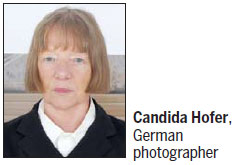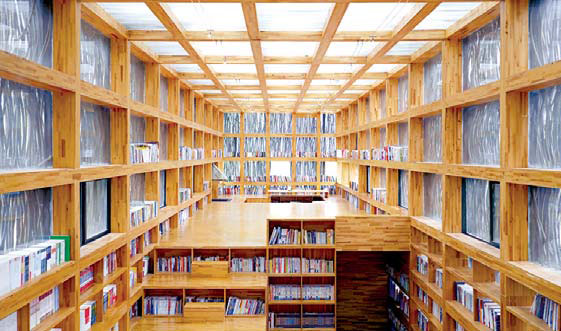Pictures fill the gaps that many take for granted

German photographer Candida Hofer puts all kinds of public spaces - libraries, museums and waiting rooms, among others - under her lens.
Her photos are dedicated to showing how these spaces look when they are empty. Hofer's first solo exhibition in Beijing was unveiled on Aug 15.
The show, On Methods, presents 72 photos spanning 41 years of her career, including both large images of empty spaces in theaters and museums, and smaller ones in specific spots such as a window or a floor piled with packages.
| Public spaces are revealed through the lens of Candida Hofer. One of her latest photos from China is of the Liyuan Library in a Beijing suburb. Candida Hofer / For China Daily |
"She is one of the most important photographers in the world. ... It's a very comprehensive show, like a retrospective, to let Chinese people know the artist better," says Peter Anders, director of the Goethe-Institut China, which helped bring the exhibition to Beijing.
On display are early works of the photographer in Germany and her latest works and images from China.
Hofer, 71, visited Beijing for the first time in 1996, and has since returned to China many times.
She took photos of different museums in Beijing before shifting her focus to architecture.
A recent photo she took was of the Liyuan Library in a Beijing suburb. It is said to be one of the country's most beautiful libraries and is well-known for its architectural design.
Each time she visits China, she notices changes, says Hofer, who has been to the country three times this year alone.
She will travel to Nanjing, Suzhou and Shanghai next month to see more of the country.
"There are more new and experimental buildings designed by Western architects in China than in Europe," she says.
When Hofer studied at the German arts academy Kunstakademie Duesseldorf, she first took pictures of people. Her series on Turkish workers in Germany earned her fame and got her noticed by her teachers.
But eventually she felt embarrassed intruding on the lives of her subjects by going into their homes to take photos. Hofer then shifted to taking pictures of public spaces.

She has visited libraries, museums, theaters and universities around the world to take photos that show how such spaces, often taken for granted by the public, can appear when empty.
Hofer once spent several months photographing Japanese conceptual artist On Kawara's iconic works on "date paintings" on walls of collectors' homes around the world.
She says it was an interesting way to show how private collectors displayed the late New York-based artist's pieces to match with the interior design of their homes.
She uses a digital camera to take many of her smaller photos. Sometimes she even uses smartphones to take a few quick pictures.
But for her work-related photos, she never uses phones, she says.
"What makes a difference between a photo and an artistic one is the attitude, the light, the right spot, and what you do later to the picture," says Hofer.
Taking a photo only takes half a day, but completing the entire process usually takes her a month, she says.
In line with Hofer's photographic style she uses the services of an interior designer to ensure her works are displayed to best effect.
The curator of the Beijing show, Herbert Burkert, says that as its title, On Method, suggests, there is a method to taking photographs and to how they are presented.
dengzhangyu@chinadaily.com.cn
(China Daily European Weekly 08/21/2015 page30)
Today's Top News
- Japan tempting fate if it interferes in the situation of Taiwan Strait
- Stable trade ties benefit China, US
- Experts advocate increasing scope of BRI to include soft power sectors
- New engine powers cargo drone expansion
- China to boost green industry cooperation
- Manufacturing PMI rises in November































